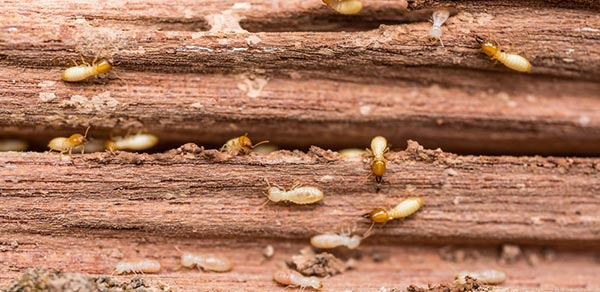 Throughout my training as a termite tech, I was constantly reminded that treated timbers are purely resistant to termite attack rather than “termite-proof”! Whether it was on the job by my mentors or during my schooling I was regularly told how treated timbers just gave termites a “gut ache” and will often build their mud leads up and over, up cracks or splits in the timber and even up through the core of the untreated section of timber. And it didn’t take long to see lots of examples of this, especially when moisture was involved, whether it be a leaky shower or treated timber in direct contact with wet or very moist soil. But it was only until recently that I come across a great example of termites actually eating their way up the “guts” of relatively dry treated timber!
Throughout my training as a termite tech, I was constantly reminded that treated timbers are purely resistant to termite attack rather than “termite-proof”! Whether it was on the job by my mentors or during my schooling I was regularly told how treated timbers just gave termites a “gut ache” and will often build their mud leads up and over, up cracks or splits in the timber and even up through the core of the untreated section of timber. And it didn’t take long to see lots of examples of this, especially when moisture was involved, whether it be a leaky shower or treated timber in direct contact with wet or very moist soil. But it was only until recently that I come across a great example of termites actually eating their way up the “guts” of relatively dry treated timber!
Now as a fully qualified termite technician witnessing Nasutitermes sp. construct a lead up the outside of a treated pine pole, or Coptotermes sp. destroy some treated framing timber left on the ground in the weather for a few years is pretty common. And I constantly use these examples to stress to my clients the importance of regular inspections despite them having a termite management system installed during construction. We all know that not all treated timbers are the same, with not only different levels of treatment (H1-H6) but different preservatives used (CCA, ASQ, LOSP, PEC Etc). Even timbers essentially treated the same can vary for various reasons, moisture content during treatment, % sapwood content, and thickness of timber just to name but a few. A good example of this is when we occasionally see a treated paling fence where one or two palings have been completely “smashed” by termites yet the remainder of the palings remain untouched. The depth of penetration of the preservative has always been a topic of debate I have had with many builders, lumber dealers and other fellow termite industry professionals. And the consensus is just as variable as the level of the treatment itself. Interestingly though the treatment of freshly cut ends of treated timbers has always been strongly recommending by our industry but rarely if ever performed by the tradesman cutting the timber. So it is always reassuring when we see first-hand examples of what we preach and recommend.
During a recent standard annual termite inspection on a relatively new suspended floor home. I quickly observed the client had built in, or enclosed to create a bit of a storage area beneath the home. The client had tried to do the right thing by using treated timber, however the timbers were in direct contact with the sandy soil and the house itself. So as per all potential bridging points like this quickly made the recommendation to “trim” or cut the timber to separate the direct connection with house. Before I had even finished the how and why part of the conversation the client had dragged out his reciprocating saw and started to make the recommended adjustments. What we both observed next could not have been scripted any better. Just as I had forewarned termites had already started munching their way up the core of the treated framing timber, totally concealed. However what I would not have predicted was the species responsible for this potential breach.
Microcerotermes sp. is a very common species in my area but only occasionally detected in housing timbers, but in this case I guess they decided to make an exception to the rule and remind me not to underestimate them. Trimming of the remaining timbers revealed a similar scenario in 4 of the 6 vertical timbers. The highest they had travelled was only a few inches above ground level, so they still had a long way to go, but that was enough for the client to totally rethink his design and make some serious changes beyond just trimming the timbers.
There are days when I feel everything I am reporting on is just generic recommendations to keep my insurer happy, but it’s day’s like these and clients like this that make my (our) job so rewarding. It also reminds me that just because I haven’t seen it happen don’t mean it can’t happen. We in this industry are constantly learning and seeing things we haven’t seen before, so it would be sheer arrogance to assume we know it all. The more we learn, the more we learn how much we don’t know!
Written By Jay Turner

